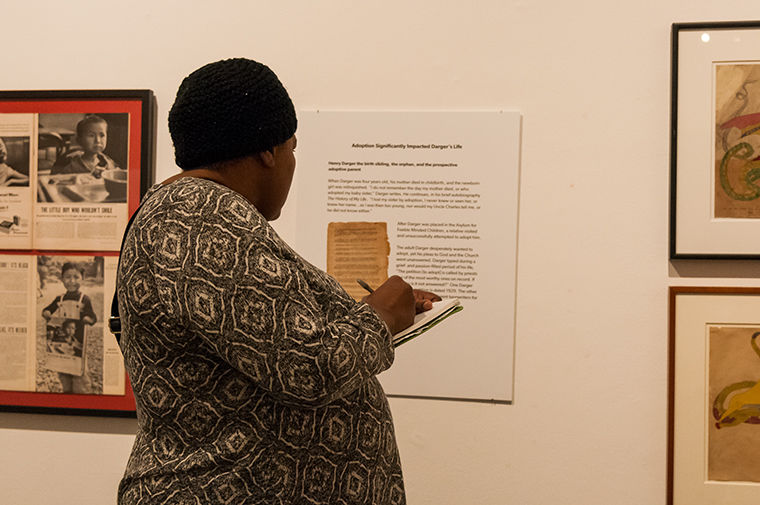Workshop discusses art, poetry, accessibility
Poetry workshop participants walked around the gallery and wrote down words that jumped out to them from the artwork and descriptions around the gallery.
November 6, 2017
How do poetry and illustration cooperate with one another?
On the evening of Nov. 2, a group of about 10 poets gathered to discuss and experiment with the use of illustration in verse.
Hosted by Intuit: The Center for Intuitive and Outsider Art, 756 N. Milwaukee Ave., in collaboration with the Poetry Foundation, 61 W. Superior St., the event was led by Maggie Queeney, the foundation’s poetry coordinator. Participants discussed poets who have used text and imagery in their work.
“When you get down to it, poems are pleasing,” Queeney said. “It pleases our ear to hear rhyme. The visual field is just another field of pleasure, and also a field for symbolic meaning to open up.”
Queeney added that the addition of visual artwork to verse is a way to make the piece accessible to readers who might otherwise be intimidated by poetry by allowing them to approach the poem through a comfortable and familiar lens.
Queeney also said the illustrated poetry triggered discussion of issues such as gender, art consumption and accessibility—commonplace struggles for Chicago artists and poets.
Mark Turcotte, Turtle Mountain Chippewa, poet and senior lecturer at DePaul University, used to be a skeptic about visuals in poetry, but his opinion has changed.
“As long as the art stands alone and the poem stands alone, I think they’re great,” Turcotte said, explaining that both the poem and the illustration have to equally contribute to the theme.
The Nov. 2 workshop was held in conjunction with a yearlong celebration Intuit is holding to honor the work and 125th birthday of Henry Darger, Chicago’s premier outsider artist.
Darger was a Chicago dishwasher and janitor whose 15,000-page illustrated manuscript was discovered after his death. While he was not a poet, the illustrations that accompanied his manuscript “In the Realms of the Unreal” gave his work the same kind of visual and textual relationship the workshop explored, according to Joel Javier, education manager at Intuit.
“When you’re sifting through the entire novel, he takes readers and viewers on a journey,” Javier said. He compared the “In the Realms of the Unreal” to a graphic novel, in which artwork acts as an extension of a story rather than just an aesthetic addition to it.
Queeney said visual poetry’s increased popularity is similar to that of graphic novels and poetry comics, which combine poetry with the comic strip format.
“It’s all a part of this amorphous opening up of what a poem can be,” Queeney said.
Queeney also explained the purpose of collaborating with groups like Intuit is to generate a dialogue about often undiscussed day-to-day challenges people face that can be processed or addressed through poetry.
“Part of what I’m committed to doing is building partnerships that bring poetry to new audiences throughout Chicago,” Queeney said, “folks who maybe wouldn’t come to the Poetry Foundation specifically to read and talk about a poem, but who have been to Intuit, for example, and are leaning toward visual arts themselves, [so we can] have that conversation between poetry and visual art.”








